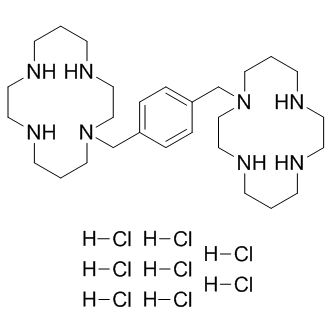| Cas No.: | 155148-31-5 |
| Chemical Name: | Plerixafor HCl |
| Synonyms: | AMD3100; AMD-3100; AMD 3100; JM 3100; JM3100; JM-3100; SDZ-SID-791; JLK-169; SID-791; JM-2987; Plerixafor HCl; MOZOBIL. |
| SMILES: | C1CNCCN(CC2C=CC(CN3CCNCCCNCCNCCC3)=CC=2)CCCNCCNC1.Cl.Cl.Cl.Cl.Cl.Cl.Cl.Cl |
| Formula: | C28H62Cl8N8 |
| M.Wt: | 794.46 |
| Sotrage: | 2 years -20°C Powder, 2 weeks 4°C in DMSO, 6 months -80°C in DMSO |
| Description: | Plerixafor octahydrochloride is a selective CXCR4 antagonist with an IC50 of 44 nM. |
| In Vivo: | Plerixafor (2 mg/kg) administration to UUO mice exacerbates renal interstitial T cell infiltration, resulting in increased production of the pro-inflammatory cytokines IL-6 and IFN-γ and decreased expression of the anti-inflammatory cytokine IL-10[3]. Both perivascular and interstitial fibrosis are significantly reduced by the CXCR4 antagonist, Plerixafor (AMD3100) at 8 weeks[4]. LD50, mouse, SC: 16.3 mg/kg; LD50, rat, SC: >50 mg/kg; LD50, mouse and rat, IV injection: 5.2 mg/kg. |
| In Vitro: | The CXCR4 inhibitor Plerixafor (AMD3100) is a potent inhibitor of CXCL12-mediated chemotaxis (IC50, 5.7 nM) with a potency slightly better than its affinity for CXCR4. Treating the cells with CCX771 or CXCL11 has no effect on CXCL12-mediated MOLT-4 or U937 TEM. In contrast, 10 μM Plerixafor inhibits CXCL12-mediated TEM in both cells lines[1]. Plerixafor (10 μM)-treated cells show a moderate reduction in cell proliferation compared to CXCL12-stimulated cells, which do not reach statistical significance[2]. |






















